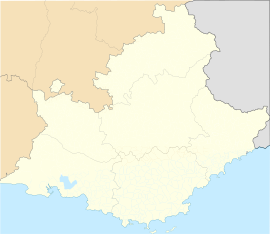Mont-Dauphin
Mont-Dauphin | |
|---|---|
 Fort | |
 Coat of arms | |
show Location of Mont-Dauphin | |
 Mont-Dauphin | |
| Coordinates: 44°40′12″N 6°37′28″E / 44.67°N 6.6244°ECoordinates: 44°40′12″N 6°37′28″E / 44.67°N 6.6244°E | |
| Country | France |
| Region | Provence-Alpes-Côte d'Azur |
| Department | Hautes-Alpes |
| Arrondissement | Briançon |
| Canton | Guillestre |
| Government | |
| • Mayor (2020–2026) | Cyr Piaton[1] |
| Area 1 | 0.58 km2 (0.22 sq mi) |
| Population (Jan. 2018)[2] | 174 |
| • Density | 300/km2 (780/sq mi) |
| Time zone | UTC+01:00 (CET) |
| • Summer (DST) | UTC+02:00 (CEST) |
| INSEE/Postal code | 05082 /05600 |
| Elevation | 898–1,035 m (2,946–3,396 ft) (avg. 1,050 m or 3,440 ft) |
| 1 French Land Register data, which excludes lakes, ponds, glaciers > 1 km2 (0.386 sq mi or 247 acres) and river estuaries. | |
Mont-Dauphin is a commune in the Hautes-Alpes department in southeastern France.
At the confluence of Durance and Guil rivers, overlooking the impressive canyon of the latter flowing down from Queyras valleys, Mont-Dauphin is one of the many places fortified by Vauban in the second half of the 17th century.
In 2008, the place forte of Mont-Dauphin, was listed as a UNESCO World Heritage Site, as part of the "Fortifications of Vauban" group.
Population[]
|
|
See also[]
- Communes of the Hautes-Alpes department
References[]
- ^ "Répertoire national des élus: les maires". data.gouv.fr, Plateforme ouverte des données publiques françaises (in French). 2 December 2020.
- ^ "Populations légales 2018". INSEE. 28 December 2020.
External links[]
| Wikimedia Commons has media related to Mont-Dauphin. |
- Official site
- MontDauphin.com : webcams, meteo, pictures, everything about Vauban's Castle (French)
- Webpage about the fortifications
Categories:
- Communes of Hautes-Alpes
- Vauban fortifications in France
- Hautes-Alpes geography stubs



